Is Hut-to-Hut Running on Your Bucket List? It Should Be.
This article originally appeared on Trail Runner
The magic of the Colorado hut-to-hut trip really sunk in when the puzzles came out. Puzzles and whiskey.
It was day two, the second hut of a four-day Hut Run Hut trip hosted by Salomon and Rickey Gates, writer and trail runner legend. There were six runners, including me, all arriving from various parts of the country to enjoy a multiday route designed by Gates that would string together a series of high elevation huts, two of which were part of the 10th Mountain Division hut system.
Four days. Three nights. Forty-five miles. Each day's run would include 9 to 15 miles with 3,000 vertical feet of climbing. This was no race, no FKT pace. Rather, it was a multi-day running experience within Colorado's White River National Forest joined by several others for an extended period of time.
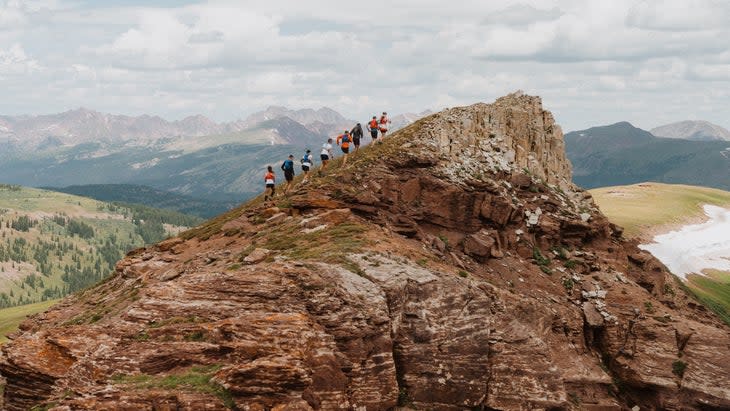
OK, back to the puzzle. That evening, after a dinner of sausages and salad, a few circled around the jigsaw puzzle by headlamp. Some drank whiskey. Others sipped tea. All fiddled with puzzle pieces and shared about their lives and running goals, all huddled in the warmth of a high elevation hut after two days running across some of the most gorgeous terrain in the world.
If something like this, a four-day trail running adventure along Colorado's high country ridgelines during peak wildflower season, sounds like an activity you'd be keen to pursue, the following is a primer for where to start: what makes hut running so unique, what gear necessary you might consider, and what options there are out there for you to start planning.
What Is Hut Running?
A hut-to-hut trip is any multiday adventure that links up a series of established fortified sleeping structures in the backcountry. Most hut link-ups have traditionally been designed with hikers, backpackers, skiers, and mountaineers in mind, but running between huts is fully compatible and can offer a whole new level of adventure.
Depending on the location, huts vary in quality and amenities, from rustic lean-tos to full-staffed cabins with electricity, running water, warm meals, and beds. What you'll find in the huts of New Hampshire's White Mountains, for example, will look quite different than hut accommodations in northern Italy's Dolomite hut system. Common denominators include walled shelter, a place to prepare food, and a bathroom of some kind.
Doug Mayer is the founder of Run the Alps and a long-time organizer of multiday hut trips in and around Chamonix, France. To Mayer, the secret sauce of hut running is in the extended time within a landscape.
"A hut trip is a great way to mix trail running with the alpine world," says Mayer. "You get to stay high, often interacting with technical climbers and having an in-depth interaction with alpine culture. Also, you can step outside the hut at night, walk a few feet, and find yourself in a magical, high mountain environment. At some of the huts we use, you literally get to sleep next to a glacier."
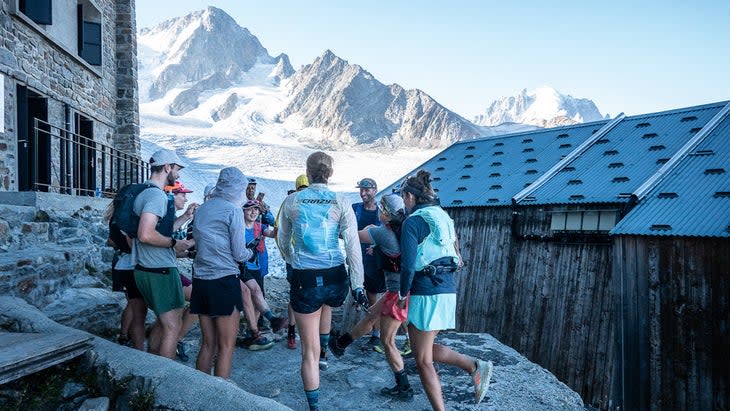
What's also special about hut running is that it's never quite the same wherever you go. "In Europe, hut culture is dramatically different than in the U.S." says Mayer. "There's no differentiation between frontcountry and backcountry in the Alps. So huts are closer to remote, high-elevation hotels, complete with great meals, wine, and beer, and other services."
Compare this to Ecuador's Cotopaxi hut route, which provides a whole new level of experience and challenge. "Ecuador has all the ingredients for a world-class hut-to-hut trail running trip: stunning landscapes, a web of rugged mountain trails, colorful haciendas with regional food, warm showers, beds to crash in," wrote Andy Cochrane after following the demanding five-day route. "The infrastructure is basic compared to popular hut-to-hut routes in Europe, but the novelty drew us to its less-beaten path."
For Gates's Colorado Hut Run Hut trip, the 10th Mountain Division huts were part of a network of over 30 shelters dotted across the Rockies, the first constructed in the early 1980s and adhering to a similar layout and accommodation: a simple bunk loft with several cots and pads, a wood fired stove, and a full kitchen with running water, propane, and electricity. (His crew provided sleeping bags and liners.)
Why Should You Consider a Hut Running Trip?
In a time of growing interest in trail running, more races are available than ever before, domestically and internationally. There's also been an emerging trend of alternative running destination experiences that emphasize the experiential and communal over single-day competition. Popular options include Aspire Adventure Running, Rogue Expeditions, to name a few. But hut running offers something even more unique within this space of experiential foot travel.
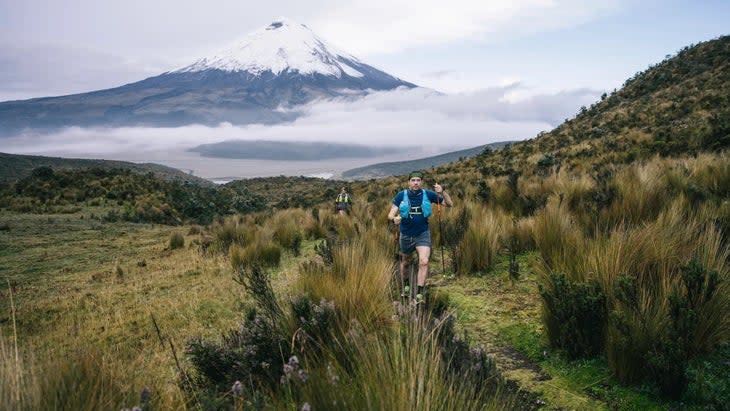
Here are four distinct benefits that differentiate hut-to-hut trips:
1. Community. The social component of hut-to-hut running is an underappreciated, central component. If you're with a group, each participant is invited to make their way every day as a collective, though most spread out along the trail for most of the day. Alongside demands of covering the miles, there are often evenings with food and games, and plenty of downtime to get to know each other. Even if you're customizing your own hut trip, accommodations are typically shared, so chances are you'll rub shoulders with people each night.
2. Extended Time Outdoors. To be away from phones and laptops and be enmeshed in a landscape for multiple days on end is a valuable--if not exceedingly rare--experience these days. A hut trip offers just that: multiple days strung together, often point-to-point runs at a manageable pace, doing what you love while undistracted by work or frontcountry temptations. Hut running scratches the itch of overnights on the trail and yet, unlike backpacking, offers a chance to travel light and fast over longer distances with little gear.
3. Retreat. If your life does not permit you to take up residency in a mountain monastery or pledge ascetic minimalism for a year--welcome to the club. But that doesn't mean you can't engineer smaller, shorter retreats into your schedule, a fail-safe antidote to burnout. According to a recent 2023 Gallup study, "about three in four employees in the U.S. experience workplace burnout at least sometimes, and about one in four experience burnout either 'very often' or 'always.' If this is you, hut running might be a helpful counterbalance.
"It's an experience you won't find anywhere else, especially for those who feel like they need a break from work and technology," says Seth Epley, a Hut Run Hut participant from Austin, Texas. "Climbing up a mountain, drinking glacial melt, overlooking a horizon of peaks and ridges--it's all just very revitalizing."
That's just it, hut-to-hut running's winning formula: a prolonged opportunity to pause, a suspended exhalation in wild space surrounded by like-minded people, an accessible form of active wilderness retreat that can return you to work or daily life feeling recalibrated.
4. Accomplishment. Gates has been organizing these Colorado Hut Run Hut trips since 2014, and his typical offering is a six-day, 100-mile trip from Aspen to Red Cliff. He's expanded the trips to include running experiences in New Mexico, Alaska, and Japan, and yet what continues to inspire him every time is watching people set hard challenges for themselves and making them happen.
"The most powerful moment for me on these trips is seeing the looks on peoples' faces when they've accomplished something they didn't know they had in them," says Gates. On this Colorado hut trip, while some runners were familiar with high elevation running, others arrived from lower elevations and were forced to push their personal edges, to great benefit.
This included Tonya Russell, a freelance writer and avid road runner from Philadelphia. Her hut experience sparked a whole new love for running, even after having some low moments.
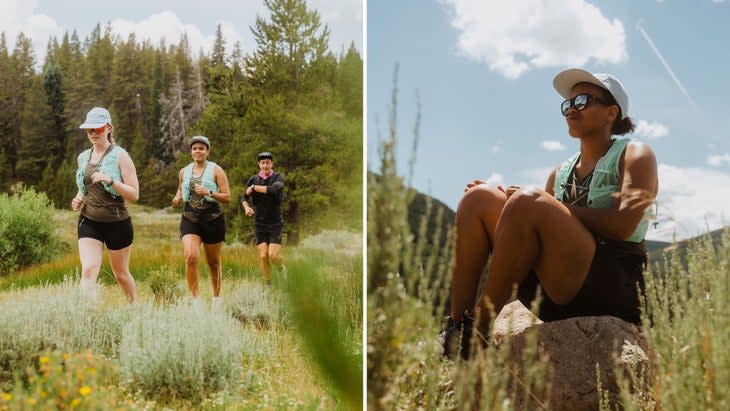
"Forcing myself to take on the challenge taught me how much of a beating my body could take, but also, the prize of trail running eventually revealed itself," she said. "During the tough parts, I picked apart the miles, trying to conceptualize how long it would take to finish, about how many minutes would get me to the next mile. My guide, Gus, would say: 'Don't worry about the time. We'll get there when we get there.'"
Essential Hut-to-Hut Gear Pieces
Some hut running experiences shuttle your bags, which means that all you must carry is a day's worth of water, nutrition, and layers. Others, like Run the Alps, have options for guides to help carry some gear, but most runners carry all they need, sans bedding, for multiple days. Mayer recommends a sleep sack ("to protect against itchy classic alp hut blankets!"), a pillowcase, a lightweight change of clothes, and toiletries. This will naturally require a running vest with a little extra capacity, typically 15 to 20 liters. Every organized hut running adventure will offer a region- and route-specific gear list commensurate with the miles and climate.
In general, here are a few hut-to-hut gear recommendations:
"Sacred Clothes." For Gates, it's all about leaning into comfort for the hut trips, as his crew shuttles small bags to every hut via 4x4 access roads. "Essential gear for me is a really comfortable set of hut clothes," he says. "I call them 'sacred clothes.'" The evening time is meant for recovery and socializing, so make sure you prepare with comfortable, warm clothing.
Running Vest with Extra Capacity. A sturdy running vest with enough capacity to hold water and all-weather clothing is critical. Hut running trips put you out in the elements for long days on end, and though you may have access later to a duffle bag of stuff, being prepared for unsettled weather will help your kit remain fresh and your mind strong. For my hut experience I used the Salomon Adv Skin 12.
RELATED: The Gear I Used for a Hut-to-Hut Trail-Running Trip in Switzerland
Water Filtration. Another piece of gear that's helpful is an inline water filter flask. You might consider the hut-to-hut a sort of aid station at the end of the day, but during the run you'll have to fend for yourself on hydration. Pick up a Katadyn BeFree flask or Salomon's 16-ounce xa filter soft flask and consider yourself covered.
Whole Foods. Get creative with food. For trail races, often it's best to stick to gels: simple carbohydrates and sugar, but on hut trips the pace is typically slower and you'll likely be on your feet for longer stretches with time to metabolize heartier, more whole food options. Complement with your trusted gels or sports drink with savory wraps, nut butter sandwiches, dried fruits, and bars.
Musical Instruments. Because many hut running operations are supported by a shuttle, pack that small instrument to play tunes with the group. "Some sort of musical instrument is a requirement for me on my trips," says Gates. "It can be as small as a dan moi or as large as a guitar. Music can help bring you back to your present self." (Gates brought along and played both his accordion and a ukulele.)
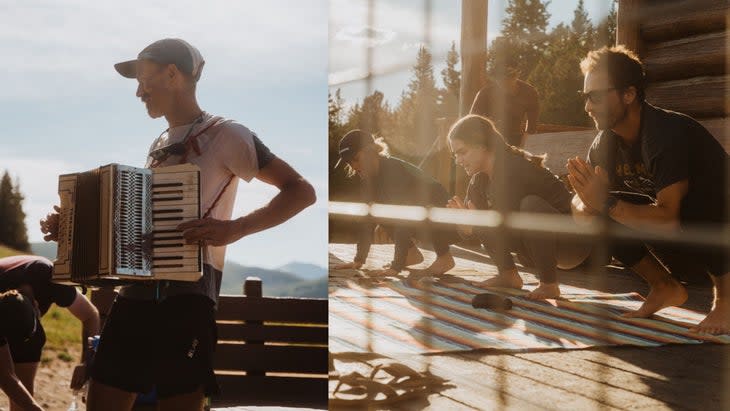
Hut Running Trips to Consider
There are a growing number of hut-to-hut routes popping up around the world, some of which are easy to self-organize, while others come as a pre-arranged package. There are pros and cons to both, but the main benefit to signing up for an organized hut trip is that hut permits and reservations have already been taken care of--which can be a pain in the ass--in addition to taking the logistics out of the equation and just requiring you to show up to do what you love most--run.
RELATED: The 13 Best Hut-to-Hut Hikes in the World
Here is a selection of six hut-to-hut running trips to jumpstart your wanderlust.
Hut Run Hut with Rickey Gate - Colorado, Japan, Alaska
Dolomite Hut System - Italy
The Cotopaxi Route - Ecuador
White Mountain Hut Traverse - New Hampshire
Otter Trail - South Africa
Run the Alps - France, Switzerland, Italy
For exclusive access to all of our fitness, gear, adventure, and travel stories, plus discounts on trips, events, and gear, sign up for Outside+ today.

